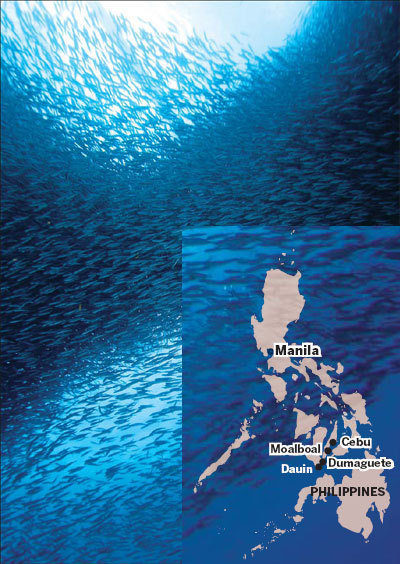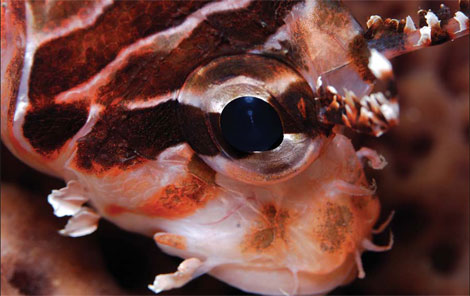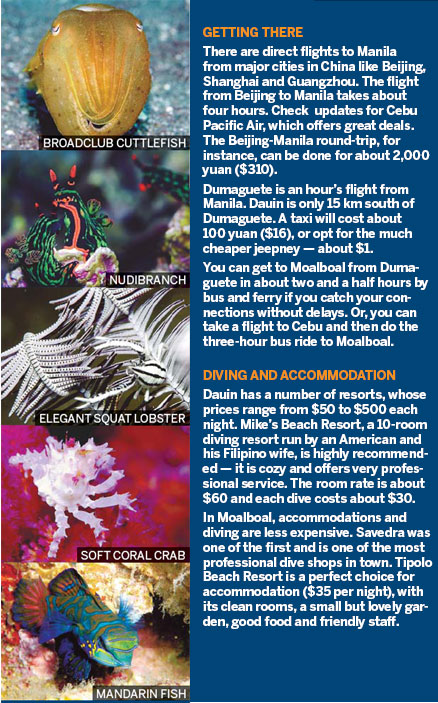Bolt from the blue
 |
|
The spectacular Sardine Run in Moalboal. Photos by Li Jin and Paloma Fernandez-Ranada / for China Daily |
 |
|
Getting up close and personal with a lionfish. |

Caught in the sardine 'tornado' off the coast of Pescador Island in Moalboal, Cebu, Ou Shuyi makes a stunning discovery.
As the last rays of the sun disappear into the horizon, an X-rated spectacle is set to unfold a few meters under water. Our group of five divers hovers around a cluster of coral debris, scanning every crack and crevice with our flashlights for signs of the big stars of the night.
Mandarin fish, in colors that bring to mind the silk robes of the mandarins of imperial China, are about to perform their fascinating love dance.
Despite their distinctive hues of blue, green, yellow and orange, mandarin fish are difficult to spot as they are just 6 cm long and appear briefly only at dusk to mate.
This is the show we have longed to see since we got hooked on scuba diving a year ago. With our new PADI certifications, we decide to dive at popular Dauin, in the Philippines.
Led by our guide Gaby, a 23-year-old Filipino, we descend to about 6 meters and settle on the bottom of a cluster of coral rubble - a stage for the mandarin fish to perform their mating ritual every night.
The surroundings are becoming dark and the fish continue to play hide and seek with us. Every time we turn our flashlights on them, they disappear in the labyrinth of corals. They are still flirting around and looking for the right partner - the climax is yet to come.
These small fish are highly sexual - the males typically tour many sites and mate with several females in one night.
Forty-five minutes pass and a growing fear grips me - I have never been underwater for such a long time. The world around us is soon enveloped in darkness and silence; all I can see are the bubbles from my regulator and the only sound I hear is that of my own breathing.
Then Gaby clanks his metal pointer against his tank to draw our attention.
A pair of fish emerge from the corals, cheek to cheek, the smaller female resting on the male's pectoral fin. This time the fish do not shy away from our flashlights. They float upward about 20 cm above the corals, in a gentle spiral, as if performing a ballet pas de deux.
Seconds later, after releasing a puff of eggs and sperm, the two separate and dart back down to the rubble. A minute or two later, another pair appears and the show goes on.
Bravo, I try to scream, but with the regulator in mouth, the only sound I can make is "Mmm ...".
Back on board, the mood is buoyant although all of us are shivering with cold.
"Seventy-two minutes! It's the longest dive I've ever had," exclaims Paloma Fernandez-Ranada, 50, from Spain. A dive veteran of 14 years, she has had numerous unforgettable underwater experiences, including swimming with whale sharks - the world's biggest fish - in the Red Sea. Yet, she is thrilled by what she has just seen.
Getting up close and personal with mandarin fish was just one of the highlights of our adventures in the Philippines.
An archipelago consisting of more than 7,000 coral-lined islands, the Philippines remains one of scuba diving's best-kept secrets.
Dauin, in the province of Negros Oriental, in the central Philippines, is a mecca for macro photography enthusiasts. Located in an active volcanic area, Dauin's beaches and seabed are mostly brown sand, and home to numerous minuscule odd-shaped critters that look like species from another planet and can only be spotted by those with eagle eyes and tons of patience.
Every one of our seven dives along Dauin's shoreline feels like a treasure hunt for marine gems.
Just minutes after we jump into the waters, Gaby shows us an ugly and deadly spiny devilfish, whose dull gray body looks like drifting debris. Seconds later, we spot a small cuttlefish, a master of camouflage, whose skin color changes from dark brown to bright yellow in the blink of an eye. Nearby, a young, blue-spotted stingray is buried at the bottom, with nothing but the cartilaginous lumps over its eyes visible.
After two days on the coast of Dauin, we head to the nearby Apo Island, for something bigger and more thrilling. The 72-hectare island, a 10-minute boat ride away, is known for its pristine coral gardens and abundance of big fish.
The moment we go under water, we are overwhelmed by Mother Nature's artistry and creativity. The dancing shafts of sunlight shoot straight down through the crystal clear water to the reefs, which resemble wild flowers swaying in the breeze. The soft coral trees and bushes bear the creator's brushstrokes in stunning green, red, yellow and orange.
The currents push us along at great speeds - we feel like we are flying over the coral gardens. Minutes later, we find ourselves swimming into a school of hundreds of jack fish, with their meter-long silver bodies glinting in the sunlight.
Yet, this is not the most exhilarating experience of our diving vacation in the Philippines.
After a weeklong stay in Dauin, we continue our exploration in Moalboal, in the province of Cebu.
It is sardines - numbering in the millions or tens of millions - that has put this small town on the tourist map. Throughout the year, the coast of Pescador Island in Moalboal plays host to the action-packed Sardine Run.
Diving amid these swirling masses is thrilling and definitely not for the faint of heart.
About 20 meters underwater we are looking around at all the interesting fish when suddenly everything goes dark. A giant "cloud" of fish appears out of nowhere and begins to descend upon us.
Within seconds, we find ourselves engulfed by millions of shimmering sardines as they swing and sway with the current. We look up but cannot see even a sliver of sunlight because of the thickly packed sardines.
Minutes later, we start to feel dizzy and our breathing quickens - panic has set in and we have lost all sense of direction. The huge shoal darts, twists and turns in perfect unison as though it were one living organism constantly changing its shape, from a cloud to a gigantic ball, to a tornado.
After about 20 minutes, this tornado of sardines swirls away, out again into the deep blue.
Just as we relax and think the action cannot not get any more intense, the giant "cloud" approaches us again, orchestrating another round of performances.
















